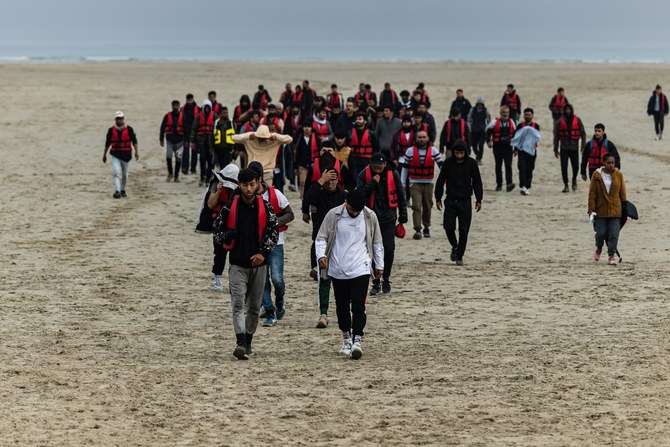Kerry Boyd Anderson
A ship carrying hundreds of migrants last week sank in the Mediterranean Sea, off the coast of Greece. There are dozens dead and hundreds still missing. Meanwhile, a BBC investigation found evidence that gangs in Iran are kidnapping and torturing Afghan migrants while demanding ransom payments. These events highlight the extreme risks that many irregular migrants face around the world. But migrants continue to attempt hazardous journeys.
Irregular migrants lack official government permission to cross a border. Some irregular migrants are refugees fleeing violence and persecution. Others seek economic opportunity. Many are fleeing both violence and economic despair in search of a safe haven and hope. Irregular migrants often lack the resources or permissions necessary to travel by safe or comfortable means, leaving them to walk extremely long distances or take unsafe forms of travel. For example, some migrants crossing through Mexico to the US jump onto dangerous trains, often riding on top. Last week’s shipwreck near Greece may be one of the worst maritime disasters in the Mediterranean, but it also represents just one of many cases in which migrants drown while attempting to travel on overcrowded boats. In the US and Europe, migrants have died due to suffocation or extreme temperatures in the backs of trucks and trailers.
Irregular migrants contend with exhaustion and exposure. Many routes pass through inhospitable environments such as mountains, deserts and rainforests. Heat, cold, rain, snow, sun exposure and more present risks. In some places, such as the Darien Gap between Colombia and Panama, snakebites and other natural hazards threaten migrants. Many drown while attempting to cross rivers. These exposures and hunger weaken migrants, leading to exhaustion and injuries. When migrants are injured or become ill, they often lack access to healthcare. Families can easily become separated. For example, there are many stories of parents losing children as they struggle through the Darien Gap, though some are reunited. When migrants drown at sea in rivers, sometimes parents or children survive but lose their family members.
Some of the worst risks come from people seeking to exploit the migrants’ desperation. Human traffickers, gangs and other criminals find many ways to profit. Some of their methods are nonviolent forms of exploitation, such as charging high prices for water, food and shoes along key routes or charging migrants for assistance crossing borders. Other forms of exploitation are very violent. The BBC found that gangs in Iran are kidnapping Afghan migrants – sometimes with the cooperation of human traffickers – and then abusing them; they send evidence of the violence to the migrants’ families and demand a ransom. Robbery is a frequent risk. Sexual abuse is a very common experience for irregular migrants, especially but not only women. Migrants face the danger of exploitation for unpaid or cheap labor and sex trafficking – both while they travel and often at their destination. Migrants who must sleep without shelter and travel along dangerous routes are at high risk of murder, beatings, rape and theft.
A look at some of the world’s most popular and dangerous routes for migrants offers a glimpse into the obstacles that they face. Afghans attempting to travel through Iran to Turkiye and then Europe often must pay traffickers and face violence from the traffickers, other criminals and border security forces. Many migrants from Africa and the Middle East face extreme risks and deprivations attempting to reach Libya and then cross by boat to Italy. However, it is the most dangerous sea route for migrants in the world. Furthermore, many migrants are detained in notoriously awful prisons in Libya. Venezuelans endure extreme environments as well as violence in their efforts to reach the US, Chile and other countries. The suffering of Central American migrants trying to reach the US starts well before they arrive at the US-Mexico border, where they face additional hurdles and dangers.
Why do so many people – including families with young children or pregnant women – attempt these difficult journeys? Sometimes, they do not fully understand the risks. Media reports suggest that traffickers often lie to migrants about the length and difficulty of a route. However, many migrants are well aware of the dangers and push on anyway. There are many stories of migrants who fail in their initial efforts to migrate but try again, often multiple times, across multiple borders. The reality is that many of these migrants have little left to lose. Many irregular migrants spend all they have, even borrowing from family or friends, to pay for their journeys. Some are robbed and have nothing left. Failure is not an option. Furthermore, many migrants are fleeing violence and deprivation at home, so violence and deprivation along the way to a potentially better life can easily be worth the risk. They seek to reunite with family who have already made it, to find safety and hope or to find economic opportunity that allows them to feed and shelter their families. Many destination countries and transit countries try to stop migrants with walls, forcing them back across borders or onto the sea and other means. While such methods might deter some migrants, they fail to address the fundamental reality that most migrants cannot give up. More effective approaches might include providing more regulated pathways for migration and helping to address the initial factors that push migrants to attempt risky journeys.







